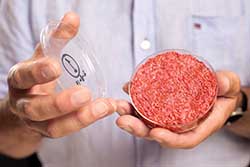Test-Tube Meat, High-Throughput Taste Evaluation
CUTTING EDGE TECHNOLOGY
 Serving up test-tube meat
Serving up test-tube meat
Meat grown in a lab may not be on dinner tables anytime soon, but a recent media event in London does demonstrate the feasibility of creating a hamburger from beef stem cells.
At the event, Professor Mark Post at the University of Maastricht in the Netherlands unveiled the lab-grown hamburger to dozens of media representatives to call attention to sustainable food production and to drum up financial support for additional research on in vitro or cultured meat. The 140-g or 5-oz hamburger cost more than $300,000 to produce and was funded primarily by Google co-founder Sergey Brin.
Chef Richard McGeown fried the hamburger—made of beef, powdered egg and breadcrumbs (binders), and beet juice and saffron (coloring agents)—in a pan with butter and safflower oil. It was served to Josh Schonwald, a Chicago-based author who wrote The Taste of Tomorrow, and Hanni Rützler, an Austrian nutritional scientist. Schonwald said it tasted like an animal protein cake, while Rützler said it was close to meat but not as juicy. The product contained no beef fat, which probably contributed to its dry consistency.
Post believes that in 10 to 20 years cultured meat could provide high-quality protein for a growing global population and middle class while negating the environmental issues and animal welfare concerns surrounding conventional livestock production. By 2050, more than 9 billion people will be consuming about 70% more animal protein than they do today.
According to various research studies and reports, cultured meat has many advantages over traditionally produced meat. Cultured meat uses 7–45% less energy, 99% less land, and 82–96% less water, and produces 78–96% less greenhouse gas emissions. In addition, the cells from a single living cow could produce 20,000 tons of cultured beef or 175 million quarter-pound hamburgers.Conventional production would require 440,000 cows.
To make the 5-oz hamburger, stem cells were extracted from the shoulder muscle of two slaughterhouse cows. The cells were placed around a hub of gel and formed rings of muscle tissue, which were cut to create strands. About 20,000 strands were required to make one burger.
High-throughput taste evaluation
Scientists at Opertech Bio, Philadelphia, Pa., have developed a proprietary apparatus and methodology for high-throughput taste evaluation. Research on the system suggests it may improve the process for discovering new flavor ingredients, measuring palatability, and optimizing flavor formulations. The findings appear in a paper, “A High Throughput In Vivo Assay For Taste Quality and Palatability,” recently published in PLOS ONE. The complete manuscript is available online at http://dx.plos.org/10.1371/journal.pone.0072391.
The manuscript describes the Microtiter Operant Gustometer, or MOG, a high-throughput system for measuring both taste quality (i.e., what does a sample taste like?) and palatability (i.e., how much do I like it?). With the MOG, rats are trained to become expert taste testers. Rats are used as subjects because of their extraordinary sensory capabilities, ease in training for complex behavioral tasks, and the substantial overlap between rat and human food preferences.
“Because of the high throughput achievable with the MOG, large amounts of sensory data can be captured in relatively short time. Such large datasets are amenable to sophisticated analyses and predictive model building. Curve fitting can be used to determine the concentration ranges in which a flavor ingredient or other taste active chemical imparts its sensory effects,” said R. Kyle Palmer, Opertech’s Chief Science Officer and lead author on the paper.
“The MOG can perform this type of analysis, rigorously and mathematically defining both taste quality and palatability characteristics, on multiple compounds or ingredients in a single test session,” he added.
If you are working on or know of some cutting edge technology that you would like to be featured in this column, please send an email to [email protected].
